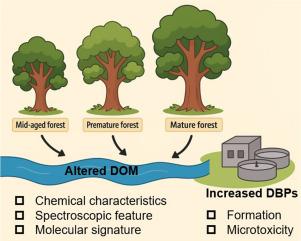Plantation forest stand age affects the characteristics and the chlorine reactivity of soil-derived dissolved organic matter
IF 12.4
1区 环境科学与生态学
Q1 ENGINEERING, ENVIRONMENTAL
引用次数: 0
Abstract
Plantation forest areas are rapidly expanding worldwide. Forests at different stand ages exhibit distinct patterns in litterfall input, soil microbial diversity, and enzyme activity, all of which potentially affect the properties of dissolved organic matter (DOM). DOM is an important precursor of disinfection byproducts (DBPs). Its quantity and chemical composition are key factors governing DBP formation potential and toxicity during water treatment. Therefore, changes in DOM characteristics driven by forest stand age can play a critical role in shaping drinking water quality. However, how plantation forest stand age affects DOM and its derived DBP remains poorly understood. Herein, this study comprehensively investigated the variations in DOM characteristics as well as the formation and toxicity of DBPs across three different stand ages (20, 30, and 34 years). Results revealed notable age-related differences in both the characteristics and composition of DOM. Specifically, a distinct shift in the abundances of DOM fluorescent components was observed. For example, the percentages of two humic-like components, C1 and C3, increased from 21% and 19% in mid-aged stage to 55% and 24% in mature stage, respectively. In contrast, the protein-like component C2 descended sharply from 60% in the mid-aged stage to 57% in the premature stage, and significantly down to 21% in the mature stage. Molecular-level analysis further confirmed a transformation from fresh and biolabile substances to more complex, chemically stable and recalcitrant compounds. More importantly, the observed variations in DOM characteristics and composition driven by increasing stand age enhanced its reactivity with chlorine, leading to a higher DBP formation potential and increased microtoxicity. For instance, DOM from mature stands showed higher reactivity with chlorine, as indicated by an increase in total organic halogen (TOX) from 0.11 mg/L in middle-aged forest to 0.20 mg/L in mature forest. Similarly, microtoxicity levels rose from 0.27 to 0.35 mg Zn²⁺ equivalents as the forest age progression. Correlation analysis revealed that the primary precursors of DBPs and associated microtoxicity were not the fresh, labile DOM fractions of microbial origin, but rather the highly aromatic, unsaturated, and humified fractions of DOM. Overall, these findings highlighted the critical role of plantation forest stand age in shaping DOM properties and reactivity with chlorine. These insights underscored the importance of incorporating forest stand age into watershed management and the need for age-informed water quality management strategies in forested watersheds.

人工林林龄影响土壤溶解有机质的特性和氯反应性
人工林面积在世界范围内迅速扩大。不同林龄的森林在凋落物输入、土壤微生物多样性和酶活性方面表现出不同的模式,所有这些都可能影响溶解有机质(DOM)的性质。DOM是消毒副产物(DBPs)的重要前体。在水处理过程中,DBP的数量和化学组成是决定DBP形成潜力和毒性的关键因素。因此,林龄驱动的DOM特征变化对饮用水水质的形成起着至关重要的作用。然而,人工林林龄如何影响DOM及其衍生的DBP仍然知之甚少。本研究全面研究了三种不同林龄(20、30和34年)下DBPs在DOM特征、形成和毒性方面的变化。结果显示,DOM的特征和组成在年龄上存在显著差异。具体来说,观察到DOM荧光成分丰度的明显变化。例如,两种腐殖质样成分C1和C3的含量分别从中年期的21%和19%增加到成熟期的55%和24%。相比之下,蛋白质样成分C2从中年期的60%急剧下降到早熟期的57%,成熟期显著下降到21%。分子水平的分析进一步证实了从新鲜和生物稳定的物质到更复杂、化学稳定和顽固的化合物的转变。更重要的是,随着林龄的增加,DOM特征和组成的变化增强了其与氯的反应性,导致DBP形成的可能性更高,微毒性增加。例如,成熟林DOM对氯的反应性较高,总有机卤素(TOX)由中年林的0.11 mg/L增加到成熟林的0.20 mg/L。同样,随着森林年龄的增长,微毒性水平从0.27 mg Zn 2 +当量上升到0.35 mg Zn 2 +当量。相关分析表明,DBPs的主要前体和相关的微毒性不是微生物来源的新鲜、不稳定的DOM组分,而是DOM的高度芳香、不饱和和腐殖化组分。总的来说,这些发现强调了人工林林龄对DOM性质和对氯反应性的影响。这些见解强调了将林分年龄纳入流域管理的重要性,以及在森林流域制定了解林分年龄的水质管理战略的必要性。
本文章由计算机程序翻译,如有差异,请以英文原文为准。
求助全文
约1分钟内获得全文
求助全文
来源期刊

Water Research
环境科学-工程:环境
CiteScore
20.80
自引率
9.40%
发文量
1307
审稿时长
38 days
期刊介绍:
Water Research, along with its open access companion journal Water Research X, serves as a platform for publishing original research papers covering various aspects of the science and technology related to the anthropogenic water cycle, water quality, and its management worldwide. The audience targeted by the journal comprises biologists, chemical engineers, chemists, civil engineers, environmental engineers, limnologists, and microbiologists. The scope of the journal include:
•Treatment processes for water and wastewaters (municipal, agricultural, industrial, and on-site treatment), including resource recovery and residuals management;
•Urban hydrology including sewer systems, stormwater management, and green infrastructure;
•Drinking water treatment and distribution;
•Potable and non-potable water reuse;
•Sanitation, public health, and risk assessment;
•Anaerobic digestion, solid and hazardous waste management, including source characterization and the effects and control of leachates and gaseous emissions;
•Contaminants (chemical, microbial, anthropogenic particles such as nanoparticles or microplastics) and related water quality sensing, monitoring, fate, and assessment;
•Anthropogenic impacts on inland, tidal, coastal and urban waters, focusing on surface and ground waters, and point and non-point sources of pollution;
•Environmental restoration, linked to surface water, groundwater and groundwater remediation;
•Analysis of the interfaces between sediments and water, and between water and atmosphere, focusing specifically on anthropogenic impacts;
•Mathematical modelling, systems analysis, machine learning, and beneficial use of big data related to the anthropogenic water cycle;
•Socio-economic, policy, and regulations studies.
 求助内容:
求助内容: 应助结果提醒方式:
应助结果提醒方式:


